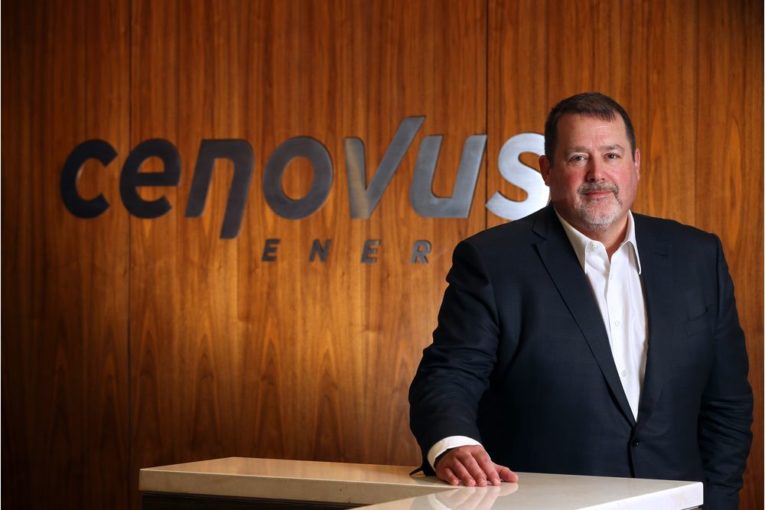
The head of Cenovus Energy believes it’s far too early to say Alberta’s crude curtailment plan is misfiring and he believes oil-by-rail-shipments out of the province will rebound soon enough.
If anything, Alex Pourbaix says his company’s tough fourth-quarter financial results show just how much damage the mammoth price discount for western Canadian oil last fall caused the sector — and the risk to Alberta if the province had not restricted production to bolster lagging prices.
In recent days, the province’s plan has been attacked by critics who maintain it is causing unintended consequences that are disrupting the economics of moving oil by rail.
“I’d like to think that people don’t have short memories, and they remember what was happening to this industry and to this province in October, November and December,” Pourbaix said in an interview Wednesday.
“We are all of six weeks in on this . . . I expect this is a very temporary impact and will be dealt with, and will be remedied, very shortly.”
The oilsands producer has been one of the most public supporters of the province’s decision to impose mandatory production cuts this year.
The Notley government ordered operators to curtail output by 325,000 barrels of oil per day in January in an effort to shrink oil inventory levels and lower the massive price discount on Western Canadian Select heavy oil.
At one point last fall, the WCS price differential to benchmark West Texas Intermediate crude sat at US$52 a barrel.
With the province now restricting output, the differential closed at $10.25 a barrel on Wednesday, according to Net Energy.
A lower differential is good news for provincial royalties and the cash flow levels of companies such as Cenovus, although integrated producers benefit from lower oil prices in their refining operations and they have vociferously opposed the province’s intervention.
The policy has come under intense criticism this month from the CEOs of industry heavyweights Suncor Energy and Imperial Oil, who contend it has pushed the differential too far in the other direction, undercutting the economics needed to ship crude by rail into the United States.
Imperial CEO Rich Kruger told reporters it costs his company $15 to $20 a barrel to move oil by rail from Alberta to the U.S. Gulf Coast. The company has brought its oil-by-rail shipments to a screeching halt, falling from almost 170,000 barrels per day (bpd) in December to near zero this month.
New data from research firm Genscape Inc. confirms crude-by-rail loadings out of Western Canada have dropped by half since December, with shipments averaging about 140,000 bpd this month.
Cenovus is headed in the other direction.
The Calgary-based company expects to increase its own oil-by-rail shipments from 20,000 barrels of oil per day in the first quarter to 100,000 bpd later in the year.
And it’s not losing money at today’s price differentials, Pourbaix pointed out.
“Anybody who is betting that $10 differentials are going to sustain for the long term is making a very risky bet,” he said.
“When people get into the rail business, this is not a spot business that you turn on and turn off on a daily basis.”
The issue leaves the Notley government in a tricky spot, trying to strike a delicate balance of keeping the differential high enough to aid producers, but low enough to incent increased rail movement so inventory levels don’t climb again.
The province has vowed to adjust the temporary curtailment levels as needed and is allowing companies to pump out an additional 75,000 bpd of oil this month.
Another refiner, Husky Energy, pointed out Wednesday its own curtailment levels have actually increased in the past month.
“We are having to shut in hundreds of wells,” said Husky spokesman Mel Duvall, noting the effect is focused on its heavy oil corridor in the Cold Lake-Lloydminster area.
“We know some of these wells being shut in aren’t going to come back.”
For Cenovus, the fourth-quarter results missed expectations and demonstrate why the province was compelled to act. Cash flow levels and earnings were both pounded by the huge oil-price discount in the October-to-December period.
The company reported a net loss of $1.35 billion, while adjusted cash flow levels came in at a $36-million loss.
Without curtailment improving the price differential for 2019, the challenges of the fourth quarter would likely have extended into the new year.
“Let’s be clear, if the government had not acted on curtailment, there’s no reason on earth to suspect (the first quarter of 2019) was going to look much different than Q4,” Pourbaix added.
“And you don’t have to be a mathematician to figure out what that impact would have been . . . you can see it was going to be a disastrous scenario for our economy.”
But curtailment can only be a temporary measure. The real solution to the problem is to get new pipelines built.
Cenovus said Wednesday it has tripled its committed capacity on TransCanada’s Keystone XL pipeline project to 150,000 barrels per day, whenever the long-awaited project is finally built.
Edward Jones analyst Jennifer Rowland said the fourth-quarter loss was a disappointing way for Cenovus to end the year, but it highlights what happens to producers vulnerable to steep price differentials.
“You have your haves and your have-nots. Anybody who is a small producer or was exposed to the WCS differential, clearly they are going to be in favour of the production cut” she said.
“Companies like Suncor and Imperial who’ve made the investments and have takeaway capacity or an integrated downstream business . . . they’re on the other side.”
And that’s why a very public oilpatch scrap over enforced production curbs continues to play out.
Like two trains headed in opposite directions, the gap between both sides continues to widen in Alberta’s testy curtailment debate.
Chris Varcoe is a Calgary Herald columnist.
You can read more of the news on source
